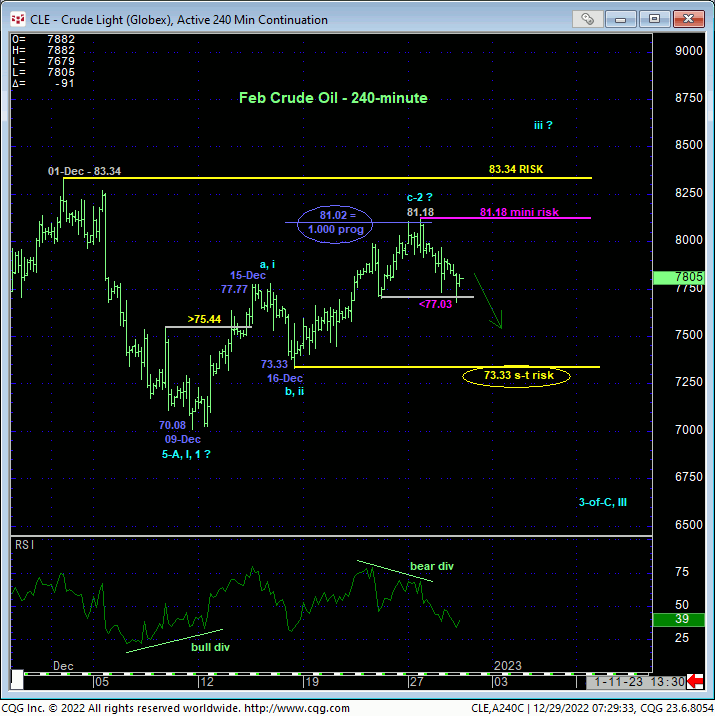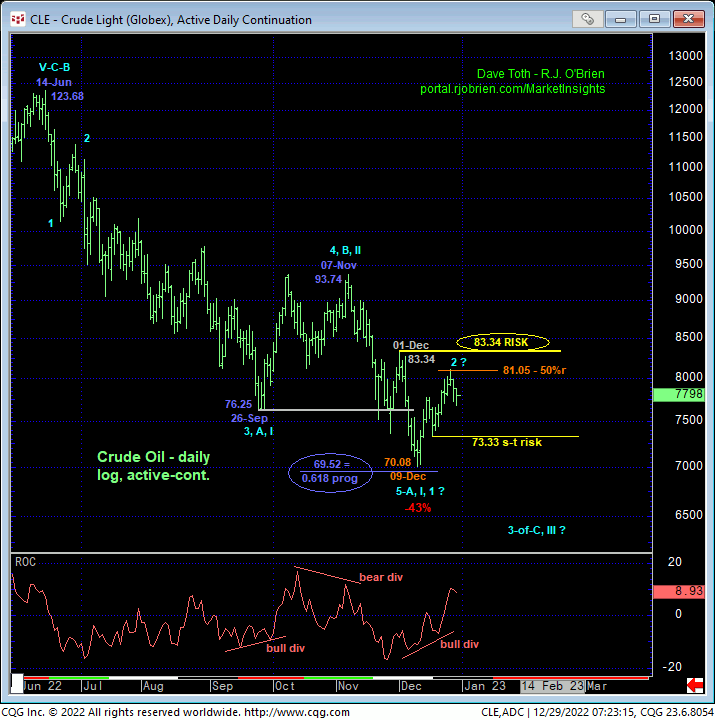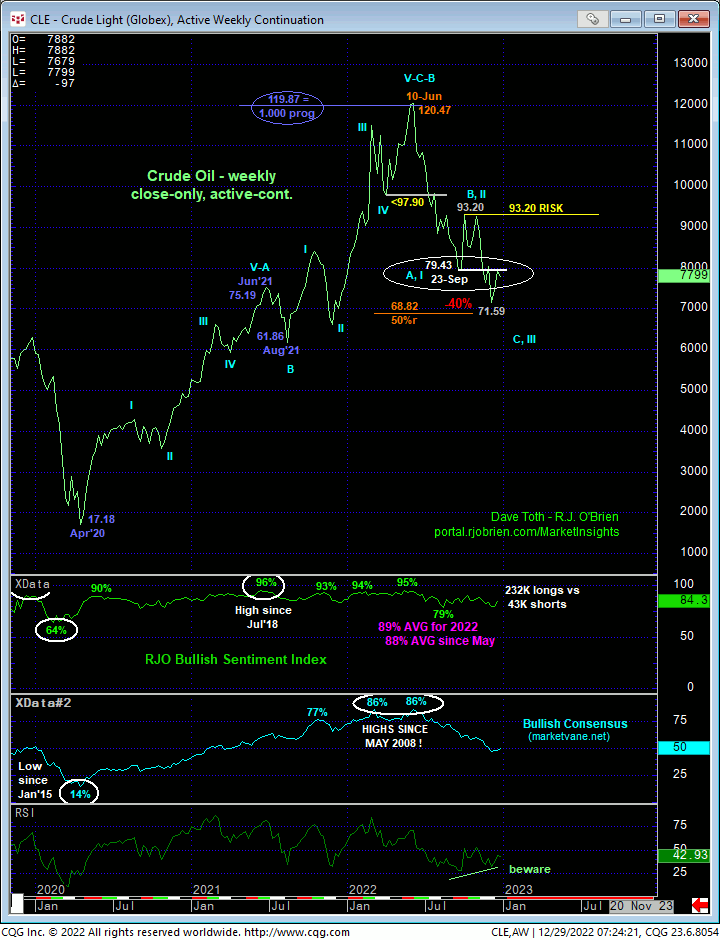
The 240-min chart below shows overnight’s slip below a minor corrective low at 77.03 from 22-Dec that confirms a bearish divergence in short-term momentum. This short-term mo failure defines Tue’s 81.18 high as one of developing importance and a mini risk parameter from which non-bullish decisions like long-covers and cautious bearish punts can be objectively based and managed.
What could prove important about this admittedly very short-term momentum failure is that the recovery from 09-Dec’s 70.08 low looks to be a textbook 3-wave structure. Left unaltered by a recovery above 81.18 and reinforced by further erosion below 16-Dec’s 73.33 corrective low, this 3-wave recovery may be considered a corrective/consolidative event that warns of a resumption of the 6-month major bear trend that preceded it to new lows below 70.08. The Fibonacci fact that the prospective c-Wave of this correction from 16-Dec’s 73.33 low spanned an almost identical length (i.e., 1.000 progression) to mid-Dec’s initial (prospective a-Wave) rally from 70.08 to 77.77 would seem to reinforce this bear market correction count. To negate this specific count and resurrect a larger-degree correction or reversal higher, the market must now recoup Tue’s 81.18 high.

From a longer-term perspective and as introduced in 13-Dec’s Technical Webcast following that day’s bullish divergence in short-term momentum, we’ve been trying to navigate a correction-vs-reversal challenge in which the short-term trend is up within the still-arguable long-term downtrend. As stated above, commensurately larger-degree weakness below 16-Dec’s 73.33 low remains required to confirm this month’s recovery as a 3-wave and thus corrective affair and re-expose the major bear. By the same token, commensurately larger-degree strength above 01-Dec’s 83.34 larger-degree corrective high remains required to break even Nov-Dec’s portion of this year’s major reversal lower, let alone threaten the major bear market from 14-Jun’s 123.68 high that has seen this market suffer a 43% drawdown. Per such, 01-Dec’s 83.34 high remains intact as our key long-term bear risk parameter pertinent to longer-term commercial players, although a negation of today’s short-term momentum failure by a recovery above 81.18 would raise the odds of an eventual poke above 83.34.

Reinforcing elements of a broader bearish count are shown in the weekly close-only chart below. First, the market remains below former 79.43-area support from 23-Sep that, since broken Nov/Dec, now serves as a key new resistance candidate. Additionally, our RJO Bullish Sentiment Index still shows the Managed Money community with its neck still grossly skewed to the bull side despite a 40% drawdown from Jun’s high weekly close. Indeed, at a still-frothy 84% reflecting a whopping 232K long positions reportable to the CFTC versus only 43K shorts, this long-&-wrong exposure remains as fuel for continued downside vulnerability. A relapse below 16-Dec’s 73.33 low and short-term bull risk parameter will likely once again put significant pressure and pain on the Managed Money community while a recovery above our long-term bear risk parameter ay 83.34 remains required to provide them a respite.

Keeping the above analysis and key flexion points at 83.34 and 73.33 in mind, we would lastly like to remind traders of this market’s return to deep, deep within the middle-half bowels of it massive historical lateral range, where the odds of aimless whipsaw risk are approached as higher, warranting a more conservative approach to risk assumption. Herein lies the importance of the specific and relatively conservative risk parameters identified at 83.34 and 73.33 and acknowledgment of and adherence to technical and trading SCALE commensurate with one’s personal risk profile. From such range-center conditions, this market may be on the verge of an excruciatingly choppy, whippy, frustrating, choppy and challenging environment. Whichever of our key risk parameters the market takes out first, subsequent volatile and challenging price action and a more conservative approach to risk assumption should NOT come as a surprise.
These issues considered, a bearish policy and exposure remain advised for longer-term commercial players with a recovery above 81.18 required to pare exposure to more conservative levels and subsequent strength above 83.34 to neutralize remaining exposure in order to circumvent the heights unknown of a larger-degree correction higher. Shorter-term traders with tighter risk profiles are advised to move to a neutral-to-cautious-bearish stance with a recovery above 81.18 required to negate this specific call, warrant its cover and reversal into a resumed cautious bullish stance. Subsequent weakness below 73.33 will reinforce a bearish count and exposure potentially sharp losses thereafter.


